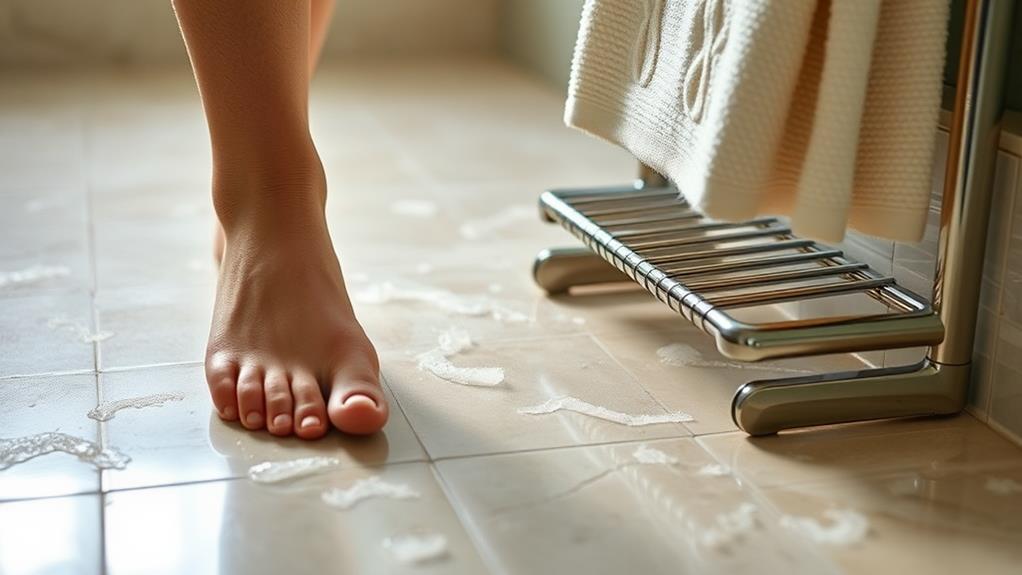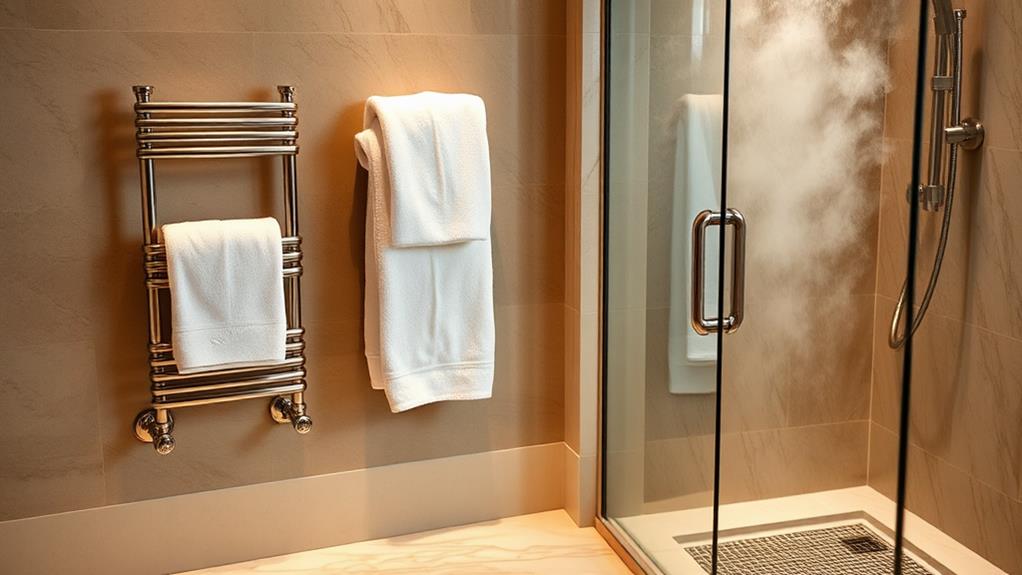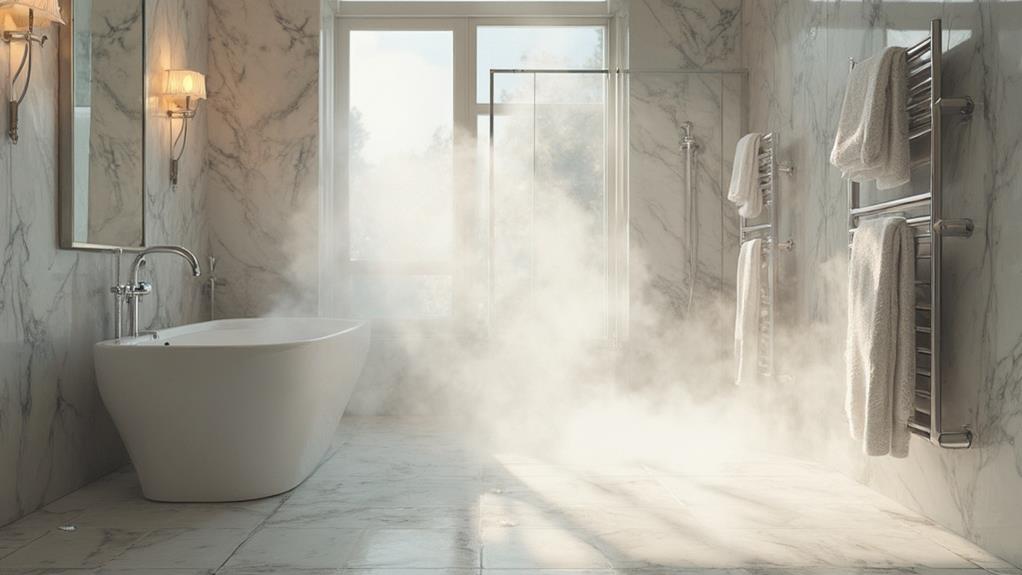Heated floors and towel racks can transform your bathroom into a luxurious oasis. You'll enjoy warm tiles underfoot on chilly mornings and cozy, dry towels after every shower. Electric or hydronic systems offer options for various budgets and spaces. When choosing a towel warmer, consider size, style, and energy efficiency. Installation complexity varies, with electric models often easier to retrofit. Proper maintenance ensures longevity, including regular cleaning and system checks. These comfort-enhancing features not only pamper you daily but can also increase your home's value. Discover how these additions can elevate your bathroom experience and create a spa-like atmosphere in your own home.
Benefits of Heated Bathroom Elements

Nearly every bathroom can benefit from heated elements. These luxurious additions can transform your daily routine, making it more comfortable and enjoyable.
Heated floors are a game-changer, especially on chilly mornings. You'll never dread stepping onto cold tiles again, as the warmth radiates through your feet and up your body. This feature not only enhances comfort but also helps dry wet floors faster, reducing slip hazards.
Heated towel racks are another excellent investment. They ensure you'll always have warm, dry towels at your fingertips. This not only feels indulgent but also helps prevent musty odors and bacterial growth on damp towels. Additionally, heated mirrors can eliminate fog, making it easier to groom yourself after a steamy shower without constantly wiping the surface.
These heated elements can also contribute to energy efficiency. By providing localized warmth, you may be able to lower your overall bathroom temperature, potentially reducing heating costs. Moreover, the added comfort might encourage you to spend less time in the shower, further saving on water and energy bills. Ultimately, heated bathroom elements combine luxury with practicality, elevating your daily routine.
Types of Heated Flooring Systems
When considering heated bathroom flooring, you'll typically encounter three main types of systems: electric, hydronic, and air-heated.
Electric systems are the most common and easiest to install. They use electric cables or mats placed beneath your flooring material. You can control them with a thermostat, allowing you to set specific temperatures and schedules. Electric systems are ideal for smaller areas and retrofit projects.
Hydronic systems circulate heated water through a network of pipes beneath your floor. They're more energy-efficient for larger spaces but require a boiler or water heater. Installation is more complex and costly, but operating costs are generally lower in the long run.
Air-heated systems are less common in residential settings. They use a furnace to pump heated air through ducts under the floor. While they can be efficient, they're typically not as effective for bathroom heating due to moisture concerns.
Each system has its pros and cons, so consider factors like installation complexity, energy efficiency, and your bathroom's size when making your choice. Remember to factor in your budget for both installation and long-term operation costs.
Choosing the Right Towel Warmer

After ensuring your feet stay warm, let's focus on keeping your towels cozy. Choosing the right towel warmer can elevate your bathroom experience significantly. Consider the size of your bathroom and the number of towels you'll need to warm. Wall-mounted racks are space-efficient, while freestanding models offer flexibility.
Material choice affects both aesthetics and performance. Stainless steel is durable and resists corrosion, while chrome-plated options provide a sleek look. For a luxurious touch, consider brass or copper finishes.
Hydronic towel warmers connect to your home's hot water system, offering energy efficiency. Electric models are easier to install and provide more consistent heat.
Think about additional features like timers or temperature controls. Some warmers double as heated towel storage, perfect for smaller bathrooms. Don't forget to check the wattage – higher wattage means faster heating but increased energy consumption.
Lastly, consider your budget. While basic models start around $100, high-end options can exceed $1,000. Balance your needs with your financial constraints to find the perfect towel warmer for your bathroom oasis.
Installation and Energy Considerations
Installation complexity and energy efficiency are crucial factors to consider when selecting a towel warmer. Wall-mounted electric models are typically easier to install, often requiring only a nearby electrical outlet. Hardwired versions may need professional installation, as they're connected directly to your home's electrical system. Hydronic towel warmers, which use your home's hot water supply, are more complex and usually require a plumber's expertise.
When it comes to energy consumption, most electric towel warmers use between 60 and 150 watts of power. While this is relatively low, it can add up if left on continuously. Look for models with timers or thermostats to optimize energy use. Hydronic systems are generally more energy-efficient, especially if you already have a hot water heating system in place.
Consider the size of your bathroom and your usage patterns when choosing a towel warmer. Larger units will consume more energy but may be necessary for bigger spaces or families. If you're environmentally conscious, opt for models with energy-saving features or explore eco-friendly alternatives like solar-powered options. Remember, proper insulation in your bathroom can also help reduce overall energy consumption.
Maintenance and Longevity

Proper maintenance of your towel warmer is crucial for ensuring its longevity and optimal performance. To keep your heated towel rack in top condition, regularly clean it with a soft, damp cloth and mild soap. Avoid using abrasive cleaners or scrubbers that could damage the finish.
For electric models, check the wiring periodically for signs of wear or damage, and have any issues addressed by a professional electrician.
If you've installed a hydronic towel warmer, bleed the system annually to remove any trapped air that could reduce efficiency. Keep an eye out for leaks and address them promptly to prevent water damage. For both electric and hydronic models, inspect the mounting brackets regularly to ensure they're secure.
As for heated floors, they typically require minimal maintenance. However, be cautious when using area rugs or heavy furniture on heated floors, as these can trap heat and potentially damage the system. If you notice cold spots or inconsistent heating, consult a professional to diagnose and resolve the issue.
With proper care, your heated bathroom features can provide comfort and functionality for many years to come.
Conclusion
You've explored the luxurious world of heated bathroom elements. From cozy floors to warm towels, these additions can transform your daily routine. Remember, proper installation and maintenance are key to enjoying these comforts for years to come. Did you know that radiant floor heating can reduce energy costs by up to 15% compared to traditional heating methods? It's not just about comfort; it's a smart investment in your home and well-being.

